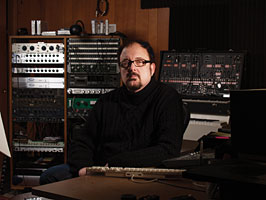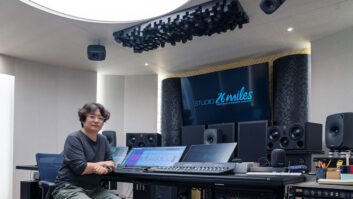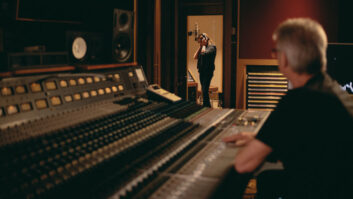
Steve Fisk in his control room at home, surrounded by top gear
Photo: Francisco Macias O
In this exclusive story, Seattle-based producer/engineer Steve Fisk describes producing the recording sessions for San Francisco Bay Area singer/songwriter Paul Manousos’ 2008 release, Common Thread (reviewed in Mix’s April 2008 “Cool Spins”), which took place in San Francisco studio Tiny Telephone. Fisk also shares a story about his work producing Nirvana’s 1990 Blew EP with Kurt Cobain, Krist Novoselic and Chad Channing, a project that took place between the band’s 1989 debut album, Bleach, and its epic 1991 breakout effort co-produced by Butch Vig, Nevermind.
For more information on Fisk, visit www.stevefisk.com and www.myspace.com/stevefisk.
Could you talk about tracking Paul Manousos’ album Common Thread at Tiny Telephone?
We spent some time in pre-production before we went in. There was a great effort to try to get the whole thing down live, because Paul is such a strong singer and his band plays with some good dynamics. And we ended up in some interesting situations, where [his] voice was actually bleeding into the guitars instead of the guitars bleeding into the drums or something like that. He went for some big notes that actually were getting into every other mic in the room. It was pretty spooky. You’ll hear that on the record. If he’s redone a vocal, you’ll hear a ghost of the original vocal on the drum track.
There are some really good accidents; that’s the ear candy that I grew up listening to on ’60s and ’70s records—all these tambourines and count-offs leaking in here and there. So, [in] starting with so much live tracking, we definitely have some interesting bleed on the record. We had everybody out on the floor with some baffles up in-between.
The band’s approach is a little loose, so the different takes have cool things about them. [Tiny Telephone owner John] Vanderslice’s studio is definitely set up to make that happen. The engineer I worked with, [Tiny Telephone staff engineer] Ian Pellicci, knows the place inside and out; he’s very quick. It’s always great to work with a guy that’s got the room figured out. [If] you listen to the new Paul Manousos record [you’ll find that] the songs definitely have their own character and their own tone, and their own sonic palette.
I’ve been playing with an old-fashioned [drum-] miking technique, something that a friend [Stuart Hallerman, producer/owner of Avast Recording Company in Seattle] of a friend picked up from Phill Brown, the famous ’70s producer who did Traffic, The Rolling Stones, Bob Marley and all that. There was a way of getting the mics in the four channels that not only seems to work with everybody I’ve worked with in the last year and a half, but also is perfect for recording [in] the living room [laughs] and a few other things like that. We have one mic behind the drummer and one mic in front of the drummer, and they’re aiming at each, sort of—the front mic is positioned in front of the rack tom, the mic in back looks over the drummer’s shoulder. But when you play it back you pan it, and it creates a wide stereo image. It makes the drums a complete event—it doesn’t give you cymbals over here, hi-hat over here; it’s a real complete sonic image of the drum set, which makes it very easy to do overdubs and mixing. You can spot-mic the things you need, but I’ve done several records like that recently, and it’s worked out really well. I have no idea if I’m doing the technique right because I had it explained to me by somebody who tracked something that was recorded by somebody else.
So, you learned that miking technique second- or third-hand, and then tried to re-create what was done on those earlier albums.
Let’s say I tried to make it work and I wasn’t surprised when it ended up sounding like an old Joe Cocker record or a soul record with a crazy stereo overhead imaging. It’s a mild kind of out-of-phase thing. It’s a pretty smooth sound, especially now I don’t have vinyl to worry about.
I understand that you mixed the Manousos album at home, in the box.
That’s right, and I think we did some vocal tracking here, as well. We redid a couple of the vocals here at the house.
Paul likes slap echo—[a] John Lennon–slapback kind of echo. That seemed to work really well on a couple of these songs. I also have some Master Room spring reverbs, these little three-rackspace spring reverbs that got popular about 15 years ago. They sound great with vocals, and sometimes I’ll just use a mono version of that—just put it right in the middle with a mono spring reverb behind it and get a good-sounding image.
How do you create that slap-echo effect?
I have a little blackface Echoplex, solid-state. Another thing I do is I run things out of Pro Tools and alter them pretty seriously and record them back in. So, sometimes I run [the vocal] into an Echoplex and then just re-time-align it so there is no echo, but it has this great sound of going through the Echoplex with a muted, older, lubricated tape loop and all of that. I’ll run things out to my Summit module and smack it up pretty hard, and do some funny shit with that and roll it back in. Sometimes I’ll take vocals and do extreme re-compression with the Joemeek [C2] unit and print that back into the system, and it sounds great. The Joemeek, especially when you over-dial it, it’s a wonderful sound for vocals. It gives you that whole photo-optical kind of weird compression that sounds like John Lennon or [Soundgarden’s] “Black Hole Sun,”.
What kind of work did you do with Nirvana?
Oh, just some very quick recordings with them. I did two songs in the middle of the night and started three other ones [laughs]. They dug the Screaming Trees records [that Fisk produced and played on]; we had mutual friends through that. They didn’t have any money at all. We recorded over two evenings, like 6 p.m. to 12 a.m., in an ad studio on Pike Street that had a reasonably nice MCI console and tape deck. For Nirvana, it was the first time they had been on 24-track, 2-inch format. We worked in a real hurry—got Fiberglas drum sounds, tracked five songs, finished two of them. And then that was it. They had a great sense of humor and everything, but they were very serious about their time, and worked hard. They played great. The scratch vocals ended up being the keeper vocals on the three songs that didn’t get finished, and the scratch vocals were great. They were really nice people, and everybody went home by 1, two nights in a row. Very surreal when you look back now.
Matt Gallagher is an assistant editor at Mix.







